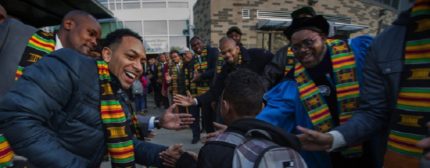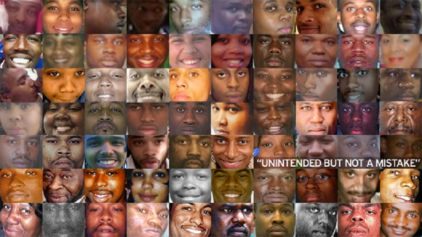
Incidents of people blaming imaginary Black men for crimes reflect the media’s role in perpetuating racial stereotypes (Photo: NBC 6).
Blame it on a Black man. In a society where Black people, particularly Black men are criminalized and vilified, negative images and stereotypes are ingrained in the public consciousness by way of the media. The media propagate images of the Black bogeyman, setting a stage for people to blame imaginary Black men for the crimes they or others committed, even for nonexistent crimes.
A man in Jonesboro, Arkansas, admitted he accidentally shot himself, after claiming a Black man shot him in the hand. The man, 20, claimed a “black male wearing all black ran up to him and pulled a gun from his hip area and pointed it at him.” He also claimed he grabbed the gun from the suspect and the gun went off and shot him in the hand. He later recanted, claiming he did not tell the truth because he did not want to go to jail.
In Staten Island, New York, a white woman named Lizzie Dunn, 52, suffered second-degree facial burns after what she described as an attack in which a Black woman with a dark complexion asked her for a cigarette and money, then sprayed her in the face with an unknown substance. The woman, who has a history of self-harm, lied to police and fabricated the attack.
In 2016, two white children in Fort Mill, South Carolina, claimed a Black man tried to abduct them. The children concocted the story to skip school.
Among the more infamous cases of people blaming it on an imaginary Black man is that of Susan Smith, who drowned her two sons, 14 months and 3 years, by strapping them in a car and letting the vehicle roll into the lake in Union, S.C., in 1994. Initially, she told the police a Black man in a knit ski cap carjacked her and kidnapped her two boys. Smith later confessed to murdering her children, and in 1995 she was sentenced to life in prison.
Linn Washington, journalism professor at Temple University Klein College of Media and Communication and a veteran journalist, says the negative media imagery of Black men is nothing new. “The reality is the media has been complicit in the demonization of Black people, particularly Black males since the inception of America,” Washington told Atlanta Black Star. “One of the first, if not the first thing published by Black males in the United States was an essay published in 1794 by Richard Allen and Absalom Jones. It was a rebuttal of a white journalist who wrote about the yellow fever epidemic. It was felt that Black people were immune to yellow fever because they came from Africa,” he added. Washington noted the first Black newspaper, Freedom’s Journal, was founded because Black people wished to tell their own story and had been misrepresented by the white media.
Black people have been fighting their criminalization through the media for years, and have even been met with violence. In November 1898 in Wilmington, North Carolina, a white mob led by an ex-Confederate officer staged an insurrection against the local municipal government that had elected Black city council members. The mob issued a white declaration of independence in which they declared they would not be ruled by Black people. “The first target of these insurrectionists was the Black newspaper in the town called the Wilmington Record. The publisher was Alexander Manly — he fled to Philadelphia,” Washington said. “Why they targeted his newspaper is he wrote an editorial to rebut an editorial written by a white woman that said lynching was a proper response for Blacks attacking white women. He said this isn’t true, the majority of interracial sex was consensual, and you cry rape when those consensual relationships were exposed. In the white declaration of independence, they said the editorial was vile and they should lynch that nigger,” Washington added.
Demands to change the media images that fuel racial prejudice and misperceptions of Black people have fallen on deaf ears. “In the 1940s, the NAACP ‘s Walter White went with Wendell Willkie [the 1940 Republican presidential nominee] and met with Hollywood producers and said what you are doing in movies is perpetuating the stereotypes and it has to stop,” Linn Washington noted. “The producers said. ‘you’re right,’ and it was big news in the Black press. And it went nowhere.”
Just as the Hollywood movie executives turned their back on the NAACP in the 1940s by failing to improve the depictions of African-Americans, America failed to heed the message of the Report of the National Advisory Commission on Civil Disorders, known as the Kerner report. Appointed by President Lyndon Johnson, the Kerner Commission released its report in March 1968 — just before the assassination of Martin Luther King Jr. — in the aftermath of the urban rebellions that rocked the country from racial oppression and police violence. The report devoted an entire chapter to the failings of the news media. “We have found a significant imbalance between what actually happened in our cities and what the newspaper, radio and television coverage of the riots told us happened,” the report said.
“Our second and fundamental criticism is that the news media have failed to analyze and report adequately on racial problems in the United States and, as a related matter, to meet the Negro’s legitimate expectations in journalism. By and large, news organizations have failed to communicate to both their black and white audiences a sense of the problems America faces and the sources of potential solutions,” the report also said. Among its recommendations, the commission called for expanded coverage of the Black community and racial problems; integrating Black people into all aspects of news coverage; recruiting and promoting more Black journalists, and establishing a privately funded and organized Institute of Urban Communications to train and educate journalists on urban affairs, among others.
“The Kerner Commission comes out in March of 1968, within two weeks of the King murder, and by May the head of the Urban League, Whitney Young, was saying the country didn’t have the will to implement the findings of the Kerner Commission report, despite praising it. In a month and a half, the country turned its back on the Kerner Commission,” Washington said, adding the mischaracterization of Black males continues today. He pointed to the 2016 sideline protests of former San Francisco 49ers quarterback Colin Kaepernick, and the failure of the national news coverage to mention that when the NFL player first took a knee during the pregame playing of the national anthem, police brutality was a problem in the San Francisco. The city police commissioner had just resigned, and the police had killed a Black woman. While Kaepernick’s protest was about the national issue of police violence against people of color, Washington argues there was a local context of police abuse in San Francisco that also fueled the football player’s complaints. This includes protests, hunger strikes and a letter from the local police union to the NFL demanding an apology for Kaepernick’s protests.
“This is one of the faults of the media today. They provide so little context about what is going on, because Americans have such short attention spans,” Washington said of the news, offering that people “don’t understand the cognitive elements of the problems they are currently enduring. What is taught is not taught thoroughly, and that is the fault of Black people.”
Another news item which actually invented a false narrative of Black male criminality was the story of voter intimidation by two New Black Panthers in Philadelphia during the 2008 election. Fox News — the reliably conservative alternative to news networks MSNBC and CNN — painted a picture of Black Panthers standing in front of a polling place, intimidating white voters and preventing them from voting. Young white people came with video cameras as “poll watchers” to disrupt, Washington said.
Some basic reporting would have revealed the truth, however. “The narrative came out there are Black people there intimidating white people. Nobody went there to report what really happened, they never really checked what happened,” Washington noted. “The Panthers went there to protect Black elderly people, and the people who came there were wrong as the day was long. … Not one registered voter from the polling place reported voter intimidation. If the Black Panthers wanted to intimidate voters they could’ve walked four blocks … where there were more white people. Why would Black intimidators go to a Black polling place to intimidate Black voters? None of the reporters who are supposed to report the true facts took a minute to go and do it,” he added.
One of the issues blamed for the promulgation of negative images of Black people, and the coverage of negative stories at the expense of positive ones, is the underrepresentation of nonwhite professionals in the news and entertainment media, including newsroom journalists and TV writers and showrunners, the top creative executive on a broadcast program, according to studies from the American Society of Newspaper Editors and Color of Change.
However, media misrepresentations are far more complicated than a matter of black or white. Black creators of media content — filmmaker Tyler Perry, aspects of hip-hop music and videos, shows such as “Empire,” and Black reality show stars — are criticized for contributing to negative racial stereotypes. “One of the most insidious perpetrators of negative images of black males today is the genre of gangster rap (not rap music in total but gangster rap). That music is filled with lauding and applauding the worse forms of behaviors, from criminality to excessive materialism,” Washington said. “Due to how this music is presented through various mediums it is perceived outside the black community (i.e., white America) and outside the United States (in foreign nations) as the realities of black America, particularly inner-city America.”
Washington believes it is incumbent on Black leaders and educators to push back against these media mischaracterizations of Black people. “We’re not serious. We’re not doing all we should do,” he said. “As Malcolm X said, the Negro is his own worst enemy.” He pointed to polls that show many whites and white millennials believe white people are the victims of racial discrimination. ”How would they get that worldview? They are in college, they don’t have this long life of experience. They’re getting their view from their parents and from the media. The media is not doing its job on race,” Washington added, just as the media did not fulfill its duty at the time of the Kerner Report.


